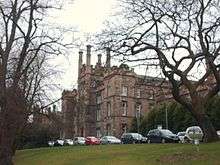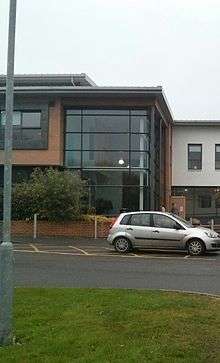Gartnavel Royal Hospital
| Gartnavel Royal Hospital | |
|---|---|
| NHS Greater Glasgow and Clyde | |
 | |
| Geography | |
| Location | Great Western Road, Glasgow, Scotland |
| Organisation | |
| Care system | NHS Scotland |
| Hospital type | Psychiatric hospital |
| Affiliated university | University of Glasgow |
| Services | |
| Emergency department | No |
| Beds | 117 |
| History | |
| Founded |
1814 1843 (moved to Gartnavel) |
| Links | |
| Lists | Hospitals in Scotland |
Gartnavel Royal Hospital is a mental health facility based in the west end of Glasgow, Scotland. It provides inpatient psychiatric care for the population of the West of the City; covering Hillhead, Partick, Scotstoun, Yoker, Clydebank, Drumchapel, Bearsden and Milngavie. It used to house the regional adolescent psychiatric unit but this has recently moved to a new psychiatric unit at Stobhill Hospital. The Hospital is a venue used by the Mental Health Tribunal for Scotland.[1] Some parts of the Hospital are classified as a category A building and is also deemed at risk.[2]
History
In 1804 the Committee of Management of the asylum was formed, construction began in 1810 and completed in 1814. Originally opened as the Glasgow Lunatic Asylum in 1814 in the Cowcaddens area of Glasgow,[3] when a royal charter was obtained it became the Glasgow Royal Lunatic Asylum in 1824.[4]
The facility moved to new premises designed by Charles Wilson in 1843,[5] the new premises were designed to allow segregation by patients' gender and social class. In 1845 the Glasgow Royal Lunatic Asylum published Gartnavel Minstrel, this is the earliest example of a publication written and edited by hospital patients.[6] These premises were again extended in 1877, 1973 and 1959. The Glasgow Royal Lunatic Asylum became the Glasgow Royal Mental Hospital in 1931 and the Gartnavel Royal Hospital in 1963.[4] Sir David Henderson was physician-superintendent at the hospital from 1921 to 1932. Donald Ewen Cameron worked at the hospital during the 1920s and R. D. Laing worked at the hospital for a number of years during the 1950s.

In December 1972, the Gartnavel General Hospital opened on the same site.[7]

As of 2006, some of the buildings are unused.[8]
2007 Renovation
The modernisation of Gartnavel Royal was completed in 2007 and today a new 117-bed hospital building serves a significant population of Glaswegian inpatients, along with mental health facilities at Stobhill Hospital and Parkhead Hospital. The modernisation cost £19 million and was said to be "the most modern and innovative building of its kind in the UK" at the time of opening. All 117 beds are within individual rooms and each has en-suite bathroom facilities. A community cafe and family room are also housed in Gartnavel Royal Hospital.[9]
Wards
Gartnavel Royal Hospital currently houses six separate wards located throughout the hospital grounds. The McNair House, Rutherford House and Henderson House wards provide care and treatment for individuals from 16-65 years of age who are experiencing any of a wide range of mental health difficulties of a severe and/or long-term nature.[10]
Intensive Psychiatric Care Units
The ICPU opened in November 2007 within the new Royal building and houses 12 beds. This ward provides intensive treatment and care for those in an acute phase of their mental illness where their needs cannot be catered to in the typical open ward setting.
McNair House Ward
The McNair House opened in November 2007 within the new Royal building and houses 20 beds. The McNair house is linked with Riverside Resource Centre and the intermediate services located at Whittingham Gardens.
Rutherford House Ward
The Rutherford House opened in November 2007 within the new Royal building and houses 20 beds. The Rutherford House is linked with both the Arndale and Riverside Resource Centres and the intermediate services at Whittingham Gardens.
Henderson House Ward
The Henderson House opened in November 2007 within the new Royal building and houses 20 beds. The ward also provides a detoxification service for clients who have drug problems. Henderson is linked with Goldenhill Resource Centre and the Intermediate Services based in the resource centre.
Cuthbertson Ward
The Cuthbertson House opened in November 2007 within the new Royal building and houses 20 beds. Cuthbertson House is a critical entry and assessment ward for people whose mental illness has been caused by a brain impairment, also known as organic mental illness – "this type of illness is usually caused by disease affecting the brain. Dementia such as Alzheimer’s disease is an example of organic illnesses".[11] This includes people who have developed Pick's and Huntingdon's disease. The ward aims to help patients achieve maximum independence and support relatives and carers through the assessment process. The ward is linked with Glenkirk Resource Centre.
Timbury House
The Timbury House opened in November 2007 within the new Royal building and houses 20 beds. Timbury House is a ward for patients older than 65 who suffer from a functional mental illness – "this type of illness has a predominantly psychological cause. It may include conditions such as depression, schizophrenia, mood disorders or anxiety."[11] The ward is linked with Glenkirk Resource Centre.
Controversy
Kenneth Pitt Incident
On 26 July 2006, an inquiry was held on the death of Kenneth Pitt, a patient at Gartnavel Royal Hospital who died at the Western Infirmary. Pitt suffered from psychotic symptoms requiring anti-psychotics and allegedly may have suffered from Asperger syndrome. Pitt was a patient of Dr David Brown between 1995 and 1997, who prescribed him various drugs to treat his symptoms. However, Pitt and his parents believed that he should have been prescribed anti-depressants and were opposed to him being forced to take the medication. It was heard at the inquiry that Pitt did not take the medication or respond to any prescriptions made out to him, additionally he did not see Dr David Brown for four years after 1997. He returned to Gartnavel Royal Hospital in 2001 after his condition failed to improve and was again prescribed medication which he refused to take; he was then prescribed alternative drugs and given two CT scans and a consultation with a psychologist. In 2003 Pitt was admitted to the McNair ward of Gartnavel Royal Hospital. Dr David Brown believed Pitt may require forcibly injected medicine if he continued to refuse his oral medication. However, his condition improved after an alternative prescription which Pitt agreed to take. During this stay, Pitt refused food and fluids given to him by hospital staff but accepted some from his parents. Dr June Ellison requested that the hospital and Pitt’s parents maintain a fluid balance chart. It was found, after Pitt’s death, that the fluid balance charts were maintained poorly and on some days had no entry at all. Pitt was found to be suffering from dehydration on 28 May 2003 and spent long periods of time lying in his bed. Kenneth Pitt’s father, Hugh Pitt, requested that he be given physiotherapy but this was not provided. The same day Pitt was found collapsed in his en-suite bathroom and could not be revived, he was transported to and pronounced dead in the Western Infirmary where he was given active resuscitation. Pitt died of pulmonary thromboembolism and it was found that it wasn’t likely that his anti-psychotic medication or Pitt’s immobility and dehydration caused the pulmonary thromboembolism. Hugh Pitt brought forward evidence that:
- The high temperature in his room at Gartnavel Royal Hospital was a major factor in his dehydration.
- Kenneth should have received the requested physiotherapy as his legs became painful and stiff due to his immobile periods in bed.
- The hospital maintained low hygiene standards in Kenneth’s room.
Samuel Cathcart, Sheriff of the hearing, finally commented
I accepted Mr Pitt's evidence that the toilet in Kenneth's room was not functioning properly and that dead flies could be seen on the windowsill. Again some support for Mr Pitt's evidence was found in that of Nurse McNair at least in relation to the toilet. These are not, however, matters which, in my view, have a direct bearing on Kenneth's death. From the evidence I heard I am unable to conclude that the medical or nursing records had been amended nor that they did not record events accurately. From the evidence led at this Inquiry, I am unable to conclude that Kenneth was forced to take a tablet by medical or nursing staff.
It was ultimately determined that Kenneth Pitt’s death was not able to be prevented.[12]
Joseph Doherty Incident
On 8 October 1998, an enquiry was held on behalf of the Mental Welfare Commission for Scotland on the death of Joseph Doherty. In 1992 Doherty killed himself with a fatal leap from Erskine Bridge, after telling hospital staff he was going for a walk. This was the eighth incident of suicide between 1985 and 1992, including Joseph Gilmartin who was killed by a bus, a woman found dead after being discharged from the hospital and a woman who strangled herself within the hospital. Doherty suffered from schizophrenia. Doherty was a patient of the Gartnavel Royal Hospital in Glasgow at the time and his family filed a complaint with the hospital. The inquiries were made, however they could not make available the information they gathered to Doherty's family.[13] Six years later during the enquiry, the family were given the outcome of the investigation with the explanation that the Mental Health (Scotland) Act of 1984 did not allow the Commission to share the information publicly. When the law changed to share the report with the complainant as well as official bodies Doherty's family were retrospectively allowed this information.[14]
References
- ↑ "MHTS Gartnavel Royal Hospital". Mental Health Tribunal For Scotland. Mental Health Tribunal For Scotland. Retrieved 14 November 2014.
- ↑ "Gartnavel Royal Hospital: East House, Great Western Road, Kelvinside". Buildings At Risk. Register for Scotland. Retrieved 14 November 2014.
- ↑ Sarah Hepworth (February 2006). "Book of the Month February 2006". Glasgow University Library. Retrieved 2006-11-28.
- 1 2 Alistair Tough (23 July 1998). "Records of Gartnavel Royal Hospital, Glasgow, Scotland". Greater Glasgow NHS Board Archive. Retrieved 2006-11-28.
- ↑ "Gartnavel Asylum". The Glasgow Story. Retrieved 2006-11-28.
- ↑ "Wellcome Library funds a new partnership to digitise 800,000 pages of mental health archives". Wellcome. Wellcome Library. Retrieved 2014-11-14.
- ↑ "Gartnavel Gala To Mark 30 Great Years". NHS Greater Glasgow. 14 October 2003. Retrieved 2006-11-29.
- ↑ "Gartnavel". Flickr. September 2005. Retrieved 2006-12-01.
- ↑ "Gartnavel Royal History". NHS Greater Glasgow and Clyde. NHS Greater Glasgow and Clyde. Retrieved 14 November 2014.
- ↑ "Gartnavel Royal Hospital". NHS Greater Glasgow and Clyde. NHS Greater Glasgow and Clyde. Retrieved 14 November 2014.
- 1 2 "Inpatient services - Older People's Mental Health". Southern Health NHS UK. Southern Health NHS UK. Retrieved 14 November 2014.
- ↑ "INQUIRY HELD UNDER FATAL ACCIDENTS AND SUDDEN DEATHS". Scot Courts. Scottish Government. Retrieved 20 November 2014.
- ↑ MacDermid, Alan. "Result of inquiry denied to family". The Herald - Scotland. The Herald - Scotland. Retrieved 27 November 2014.
- ↑ "Re: Joseph Doherty - Mental Welfare Commission Enquiry". Scottish Government. Scottish Government. Retrieved 28 November 2014.
External links
Coordinates: 55°52′59″N 4°19′05″W / 55.88314°N 4.31798°W